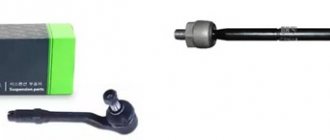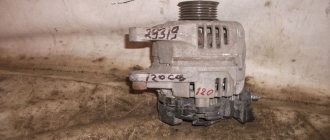The Toyota Corolla station wagon series, individually named Fielder, has been produced by the Japanese automaker since 2000. These vehicles, in addition to manual and classic automatic transmissions, were also equipped by the automaker with CVTs that use an individual transmission fluid that has a factory specification. Accordingly, next we will talk about oil tolerances for Toyota Fielder CVTs, and also give examples of original and analog products that must be purchased when servicing these CVTs.
Oil for variator Toyota Corolla Fielder
About approvals
The Toyota Corolla Fielder line has received CVT modifications:
- K110
- K111
- K112
- K310
- K311
- K312
- K313
The Japanese automaker recommends selecting transmission fluid for these CVTs according to the CVT Fluid TC or CVT Fluid FE tolerances.
Toyota Corolla Fielder variator oil K110/K111/K112
The first CVTs appeared on the Toyota Fielder in 2006. It was the second generation of this line with the index E140 that Toyota equipped with the K110 variator, the modernization of which led to the appearance of modifications K111 and K112. Initially, these machines were filled with oil with CVT Fluid TC approval, which is available in original Toyota CVT Fluid TC products. Later, namely in 2012, the Japanese automaker released an improved transmission fluid for its CVTs called Toyota CVT Fluid FE. At the same time, the specification of this oil received the nomenclature CVT Fluid FE. Accordingly, Toyota Corolla Fielder CVTs can be filled with both oil with Toyota CVT Fluid TC approval and transmission fluid with CVT Fluid FE specification. You just have to make a choice between original (Toyota CVT Fluid TC, Toyota CVT Fluid FE) and analog (TOTACHI ATF CVT MULTI-TYPE, Molygreen CVT) products.
| Toyota CVT Fluid TC | 4 liters Article: 08886-02105 Average price: 4500 rubles |
| TOTACHI ATF CVT MULTI-TYPE | 4 liters Article: 4562374691261 Average price: 3000 rubles 1 liter Article: 4562374691254 Average price: 900 rubles |
| Toyota CVT Fluid FE | 4 liters Article: 08886-02505 Average price: 5000 rubles |
| Molygreen CVT | 4 liters Article: 0470105 Average price: 3500 rubles 1 liter Article: 0470104 Average price: 1100 rubles |
Some reasons for kicks in the variator. What is normal and what is time for repairs.
IN
In this article I will talk about such a rather uncharacteristic thing for CVTs - these are kicks. We all know that CVT gearboxes don’t have any parts that, let’s say, have a hard hook, we have a belt that runs along a cone and kicks - this is a big enough reason to think about deciding to go to a service center to do diagnostics.
And here there will be 3 points because of which you might think that your box is broken. And we will try to figure out each of these points - whether they are a breakdown or whether this is the normal normal operating mode of the CVT gearbox.
All three points will go in increasing order from the very ones that I think everyone knows and to the last point, which gathers quite a large number of discussions on the forums.
- Kicks in static (Kicks when switching PRND)
- Jerks (jokes) when picking up speed (acceleration)
- Kicks when braking
Point number one.
Many people ask “why is it that when I’m parked or in neutral, then I turn on drive or shift from drive to reverse, the car is accompanied by such a small push or kick. The fact is that, I’ll say right away that this is the story: when you change gears in a static state, the car pushes forward or backward in a moderate natural amount, then this situation is the norm (It’s a slight push, not a jerk).
The fact is that on CVT cars, in order to engage the reverse or forward gear of the automatic transmission, you need to compress or release one or the other clutch pack, and when this clutch pack is compressed or released, in order to compress it accordingly, you need to create a certain pressure in the box. Accordingly, this push is precisely connected with the fact that the automation builds up pressure, the clutches are compressed, and due to the fact that the engine and gearbox are located on such cushions as they are called, or engine or automatic transmission supports, because of this, the engine tilts the box a little bit . It is because of this that such kicks appear in static conditions and I will not delve into any technical details, I will try to tell everything in a simple enough language and understandable so that any person who bought such a car will come in, look and understand absolutely everything.
I also want to note that these three points apply only to cars with CVT gearboxes equipped with a torque converter.
Second point
He probably doesn’t even refer to kicks anymore, but to such jerks, I’ll explain. Let’s imagine a situation where, let’s say, you start driving, press the gas, rev the engine up to 5000 rpm, or go to overtake, and then you press the gas and the car itself accelerates and then suddenly you notice that the tachometer needle begins to jump up sharply, or, on the contrary, stops such failures of thousands up to two revolutions and at this moment the car does not receive any acceleration. Naturally, this means you begin to understand that something most likely went wrong and this point is really a breakdown. The fact is that if somewhere you once slipped, overslipped, or very often like to tear off the wheel box, then over time the belt slips along the cones, along the surface of the cones, it develops some tracks.
The tracks have become quite deep and at the time when you accelerate, the cones converge, the belt is pushed outward from the center of these cones and when the belt passes this notch, which has already worn out, it lingers on it for a while, and the revolutions begin to jump because of this and the automatic transmission needs to apply more pressure to compress the cones in order to push out this belt so that you can accelerate further.
And unfortunately, this item is again a breakdown (you may need repair of a Mitsubishi variator - we have such a service on our website). Precisely for the reason that you won’t be driving on such roads for a long time; at some point you just turn on drive, the engine will spin up, but the car won’t move and the gearbox will go into emergency mode.
Point number three.
This point is related to kicks when braking, that is, you are driving at some constant speed and you see ahead, let’s say the red traffic light comes on and you press the brake, you begin to brake evenly, and many have noticed, especially owners of Nissan cars (We have a service for repairing Nissan CVTs) that when braking when the car has not yet reached zero speed (speed about ten twenty kilometers per hour). The car is accompanied by a certain push, after which the car begins to brake normally. I’ll say right away that this point is not a breakdown, even if you have this on your car, it’s the usual standard operation of a CVT gearbox on a torque converter, the whole point is that this kick is caused by only two factors.
The first factor is that when you apply the brakes, the torque converter comes out of lockup mode. That is, it is unlocked, thus the pump wheel is purely mechanically unhooked from the torque converter housing, because of this you feel a slight kick and after it is unblocked, an oncoming flow of liquid begins to flow from the pump wheel, which is why you see such a push small. This means that according to the tachometer needle, it twitches a little at this moment and is accompanied by a kick throughout this whole thing. Unlocking the torque converter also occurs in order to protect your gearbox and engine from some kind of shock loads. For example, the car’s automation may think that if the speed has dropped to about 0, then you can sharply press the gas and thus slightly damage the engine or gearbox, respectively, in order to dampen These oscillations of the torque converter come out of the locking mode. Plus, you can catch some kind of hole or something else, so the unlocked mode is turned on.
And the second factor that influences this is turning on the fuel supply. The fact is that when you brake, your foot is on the brake pedal and there is practically no fuel supply to the cylinder. And when the revolutions drop to about a thousand, the fuel supply turns on and because of this the arrow twitches a little.
What kind of oil to pour into the Toyota Fielder K310/K311/K312/K313 variator
Later models of Toyota Corolla Fielder received upgraded CVT modifications K310, K311, K312 and K313. For these automatic transmissions, Toyota recommends selecting transmission fluid exclusively according to the new CVT Fluid FE specification. Accordingly, it is worth purchasing both the original Toyota CVT Fluid FE oil of the same name and its substitutes. For example, German oil Fuchs TITAN CVTF FLEX or Korean transmission fluid Kixx CVTF.
| Toyota CVT Fluid FE | 4 liters Article: 08886-02505 Average price: 5000 rubles |
| Fuchs TITAN CVTF FLEX | 4 liters Article: 600669416 Average price: 3900 rubles 1 liter Article: 600546878 Average price: 1350 rubles |
| Kixx CVTF | 4 liters Article: L251944TE1 Average price: 2500 rubles 1 liter Article: L2519AL1E1 Average price: 650 rubles |
How to check the oil level in a Toyota Fielder variator
Variable gearboxes installed on Toyota Corolla Fielder station wagons do not have a dipstick, and the transmission fluid level in them is checked through the control plug:
- transmission fluid warms up to 35 degrees
- the car is placed on a level surface
- the variator selector is moved to the parking position
- unscrew the control plug from the bottom of the machine
Checking the oil level in an automatic transmission without a dipstick
Why change CVT oil?
It happens that a car breaks down at the most inopportune time. No driver wants to find himself in such a situation. To avoid this, you need to monitor the technical condition of the car. In particular, you need to monitor the power unit and gearbox.
Car owners often forget about the CVT. This is due to the fact that it is little known to drivers. However, if the variator fails, the functioning of other automotive components will be disrupted.
The variator does not require special care. It, like the engine, needs lubrication. If the oil is not changed, this will certainly affect the functioning of the engine. Its wear increases and its service life is reduced. In view of this, it is necessary to replace not only transmission and engine lubrication, but also CVT lubrication.
Original Toyota oil
Toyota Fielder has its own features. According to the automaker's recommendations, synthetics should be poured into it. This is due to the high quality of the car. The more modern the car, the more carefully it should be treated and the better the fuel and oil characteristics should be.
Ignoring the features of the Toyota Fielder can lead to its rapid breakdown. In view of this, purchase lubricants recommended by the manufacturer.
Changing the oil in the Toyota Fielder variator
Any car owner with the appropriate set of tools can partially replace the transmission fluid in the Toyota Corolla Fielder CVT. So, to change the oil in a Toyota Fielder variator, you need to:
- remove the engine crankcase protection
- unscrew the variator drain plug
- drain the old oil into a container
- dismantle the machine tray
- clean it of oil and shavings
- replace consumables
- Fill in the purchased transmission fluid maintaining the level.
Replacement procedure
Changing the CVT oil lasts approximately thirty minutes. If you once understand how it is done, then later you will have the opportunity not to contact a car service and not pay money.
Do not work with the variator immediately after turning off the engine. Wait six to seven hours. Also in the Toyota Fielder variator there is a filter that needs to be changed. You will need gloves and a waste oil basin. The replacement algorithm is as follows:
- Place the vehicle on a viewing ditch/overpass that allows the driver to stand completely. Place a board transversely under the drain, on which place a basin for used motor oil.
- Prepare fresh synthetics. You will need six and a half liters of petroleum product.
- Unscrew the drain plug.
- When the grease stops flowing, unscrew the measuring tube located near the drain. The basin must remain under the drain, as the lubricant will again begin to flow from the hole.
- Unscrew the installed CVT pan. This is necessary to carry out cleaning, eliminate wear products, contamination, and change the oil filter with lining.
- After cleaning the tray, remove dirt from the magnetic elements.
- Remove the hydraulic unit. To do this, turn off the solenoids located there and unscrew the fourteen bolts. Remember how the bolts are positioned.
- Assemble the variator and mount it back.
- When you change the pan lining, install a new oil filter, be sure to make sure that the variator pulley fits exactly into the hydraulic block cylinder. To do this, switch transmission modes when you get into the car. If everything is fine, you can start filling the variator with fresh oil fluid.
- The oil filler neck can be found by unscrewing and dismantling the left front wheel of the car. Pour in as much grease as you drained.
All these actions can be carried out with your own hands in half an hour; it is important to be vigilant when changing the oil. Remember that the variator is considered a fairly significant device that ensures the normal functioning of any vehicle, regardless of its model.
As we all know, a variator is a device that transmits torque and is also capable of softly and smoothly changing the gear ratio within a certain set control range. Many modern cars, including the Toyota Fielder, are equipped with a CVT and, as a rule, they require periodic maintenance. In principle, as for the CVT, the only thing that is necessary is to occasionally change the lubricating fluid and filter.









